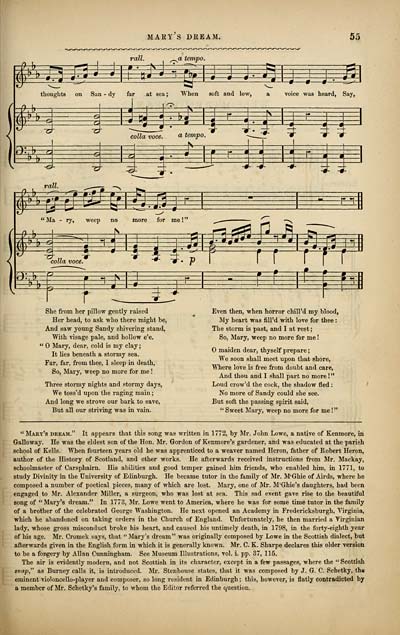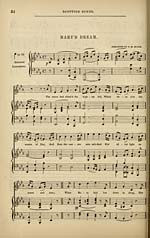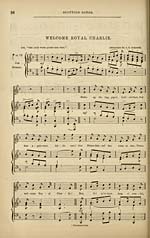Inglis Collection of printed music > Printed music > Songs of Scotland adapted to their appropriate melodies > Volume 2
(67) Page 55
Download files
Complete book:
Individual page:
Thumbnail gallery: Grid view | List view

MARY S DREAM.
55
rail.
s
^a tempo.
^^^m^^^p^^mmm
ss
thoughts on San - dy far at sea ; When soft and low, a voice was heard, Say,
a
j_j;"< Ij;
5=
^— r
coMa voce. a tempo
b — -
3
=*=*
q q 1 — F — « — J-
"27"
:p=jc
^
S
SKE
-F-=1-
55=
" Ma - ry, weep no more for me ! "
5
S
^^
_£
^fi
is
/-T-^
#
rt
fTTT
coHa voce.
P
eisEP
a
^^
?
6
-4-
V -
r
She from her pillow gently raised
Her head, to ask who there might be,
And saw young Sandy shivering stand,
With visage pale, and hollow e'e.
' Mary, dear, cold is my clay;
It lies beneath a stormy sea.
Far, far, from thee, I sleep in death,
So, Mary, weep no more for me !
Three stormy nights and stormy days,
We toss'd upon the raging main ;
And long we strove our bark to save,
But all our striving was in vain.
Even then, when horror chill'd my blood,
My heart was fill'd with love for thee :
The storm is past, and I at rest;
So, Mary, weep no more for me !
maiden dear, thyself prepare ;
We soon shall meet upon that shore,
Where love is free from doubt and care,
And thou and I shall part no more !"
Loud crow'd the cock, the shadow fled :
No more of Sandy could she see.
But soft the passing spirit said,
" Sweet Mary, weep no more for me ! "
"Mary's dream." It appears that this song was written in 1772, by Mr. John Lowe, a native of Kenmore, in
Galloway. He was the eldest son of the Hon. Mr. Gordon of Kenmore's gardener, and was educated at the parish
school of Kells. When fourteen years old he was apprenticed to a weaver named Heron, father of Robert Heron,
author of the History of Scotland, and other works. He afterwards received instructions from Mr. Mackay,
schoolmaster of Carsphairn. His abib'ties and good temper gained him friends, who enabled him, in 1771, to
study Divinity in the University of Edinburgh. He became tutor in the family of Mr. M'Ghie of Airds, where he
composed a number of poetical pieces, many of which are lost. Mary, one of Mr. M'Ghie's daughters, had been
engaged to Mr. Alexander Miller, a surgeon, who was lost at sea. This sad event gave rise to tie beautiful
song of "Mary's dream." In 1773, Mr. Lowe went to America, where he was for some time tutor in the family
of a brother of the celebrated George Washington. He next opened an Academy in Fredericksburgh, Virginia,
which he abandoned on taking orders in the Church of England. Unfortunately, he then married a Virginian
lady, whose gross misconduct broke his heart, and caused his untimely death, in 1798, in the forty-eighth year
of his age. Mr. Cromek says, that " Mary's dream" was originally composed by Lowe in the Scottish dialect, but
afterwards given in the English form in which it is generally known. Mr. C. K. Sharpe declares this older version
to be a forgery by Allan Cunningham. See Museum Illustrations, vol. i. pp. 37, 115.
The air is evidently modern, and not Scottish in its character, except in a few passages, where the " Scottish
snap" as Burney calls it, is introduced. Mr. Stenhouse states, that it was composed by J. G. C. Schetky, the
eminent violoncello-player and composer, so long resident in Edinburgh ; this, however, is flatly contradicted by
a, member of Mr. Schetky's family, to whom the Editor referred the question.
55
rail.
s
^a tempo.
^^^m^^^p^^mmm
ss
thoughts on San - dy far at sea ; When soft and low, a voice was heard, Say,
a
j_j;"< Ij;
5=
^— r
coMa voce. a tempo
b — -
3
=*=*
q q 1 — F — « — J-
"27"
:p=jc
^
S
SKE
-F-=1-
55=
" Ma - ry, weep no more for me ! "
5
S
^^
_£
^fi
is
/-T-^
#
rt
fTTT
coHa voce.
P
eisEP
a
^^
?
6
-4-
V -
r
She from her pillow gently raised
Her head, to ask who there might be,
And saw young Sandy shivering stand,
With visage pale, and hollow e'e.
' Mary, dear, cold is my clay;
It lies beneath a stormy sea.
Far, far, from thee, I sleep in death,
So, Mary, weep no more for me !
Three stormy nights and stormy days,
We toss'd upon the raging main ;
And long we strove our bark to save,
But all our striving was in vain.
Even then, when horror chill'd my blood,
My heart was fill'd with love for thee :
The storm is past, and I at rest;
So, Mary, weep no more for me !
maiden dear, thyself prepare ;
We soon shall meet upon that shore,
Where love is free from doubt and care,
And thou and I shall part no more !"
Loud crow'd the cock, the shadow fled :
No more of Sandy could she see.
But soft the passing spirit said,
" Sweet Mary, weep no more for me ! "
"Mary's dream." It appears that this song was written in 1772, by Mr. John Lowe, a native of Kenmore, in
Galloway. He was the eldest son of the Hon. Mr. Gordon of Kenmore's gardener, and was educated at the parish
school of Kells. When fourteen years old he was apprenticed to a weaver named Heron, father of Robert Heron,
author of the History of Scotland, and other works. He afterwards received instructions from Mr. Mackay,
schoolmaster of Carsphairn. His abib'ties and good temper gained him friends, who enabled him, in 1771, to
study Divinity in the University of Edinburgh. He became tutor in the family of Mr. M'Ghie of Airds, where he
composed a number of poetical pieces, many of which are lost. Mary, one of Mr. M'Ghie's daughters, had been
engaged to Mr. Alexander Miller, a surgeon, who was lost at sea. This sad event gave rise to tie beautiful
song of "Mary's dream." In 1773, Mr. Lowe went to America, where he was for some time tutor in the family
of a brother of the celebrated George Washington. He next opened an Academy in Fredericksburgh, Virginia,
which he abandoned on taking orders in the Church of England. Unfortunately, he then married a Virginian
lady, whose gross misconduct broke his heart, and caused his untimely death, in 1798, in the forty-eighth year
of his age. Mr. Cromek says, that " Mary's dream" was originally composed by Lowe in the Scottish dialect, but
afterwards given in the English form in which it is generally known. Mr. C. K. Sharpe declares this older version
to be a forgery by Allan Cunningham. See Museum Illustrations, vol. i. pp. 37, 115.
The air is evidently modern, and not Scottish in its character, except in a few passages, where the " Scottish
snap" as Burney calls it, is introduced. Mr. Stenhouse states, that it was composed by J. G. C. Schetky, the
eminent violoncello-player and composer, so long resident in Edinburgh ; this, however, is flatly contradicted by
a, member of Mr. Schetky's family, to whom the Editor referred the question.
Set display mode to: Large image | Transcription
Images and transcriptions on this page, including medium image downloads, may be used under the Creative Commons Attribution 4.0 International Licence unless otherwise stated. ![]()
| Special collections of printed music > Inglis Collection of printed music > Printed music > Songs of Scotland adapted to their appropriate melodies > Volume 2 > (67) Page 55 |
|---|
| Permanent URL | https://digital.nls.uk/94710084 |
|---|
| Shelfmark | Ing.128 |
|---|---|
| Additional NLS resources: | |
| Attribution and copyright: |
|
| Description | Scottish and English songs, military music and keyboard music of the 18th and 19th centuries. These items are from the collection of Alexander Wood Inglis of Glencorse (1854 to 1929). Also includes a few manuscripts, some treatises and other books on the subject. |
|---|
| Description | The Glen Collection and the Inglis Collection represent mainly 18th and 19th century Scottish music, including Scottish songs. The collections of Berlioz and Verdi collected by bibliographer Cecil Hopkinson contain contemporary and later editions of the works of the two composers Berlioz and Verdi. |
|---|

